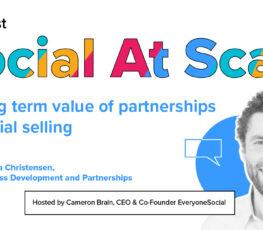Focusing on social selling at your company? It can greatly impact your sales results and affect marketing as well. Below are ten social selling strategies you cannot afford to dismiss.
Today’s buyers have changed, even more so since social media has evolved into a key piece of your company’s sales strategy.
Now buyers, in both a B2B and B2C have instant access to information on their devices, meaning that they can reach out to your competitors at a moment’s notice.
It’s also challenging for companies to reach these high-value buyers because the competition for audience attention is so fierce.
This is why more salespeople recognize the branding value of content marketing assets and social media.
Check out these stats from Vengreso if your team needs some convincing of the power of sales content and social media.
But here’s a little secret: when you approach selling the right way, the recipients of your sales pitch don’t feel like they’re being sold to at all.
In fact, the companies (and their employees) who really nail social selling make the “transaction” feel like more of a two-way conversation, one that provides more value to the listener than to the communicator.
The key to implementing a successful social selling strategy is to create the right types of conversation, capture the engaged listeners, and connect them with the appropriate channel or channels of your business.
All while ensuring that your voice is authentic and approachable.
Leave your hard sell at the door.
What does social selling involve?
- Endorsing a customer on LinkedIn.
- Running LinkedIn searches for potential targets.
- Liking a client’s Facebook post.
- Sharing the company’s latest blog post on Twitter, LinkedIn, Facebook and Google+.
- Studying prospects on LinkedIn and Twitter before a meeting.
- Following key accounts on Twitter.
- Retweeting a client.
What isn’t social selling? Probably everything you’ve always associated with sales: locking down deals, cold-calling, and quota-building “magic” strategies.
Social selling is often a collaborative effort between your sales and marketing team, fueled by organic human interactions.
Your social selling strategies are most effective when your employees leverage their own social presence to share positive news, stories, and insights about their company with their networks.
To really move the needle (and your bottom line), we’ve rounded up some of our favorite recommendations from internet industry experts.
Related: Before diving in below, make sure you have our complete social selling guide to get you on the right track. Download your free copy here.

1. Understand what you’re selling, and why.
A lot of managers miss the mark when it comes to educating employees about what they’re selling, and why. Blasting your employees with a hundred articles that they should be posting on their LinkedIn profile isn’t exactly going to result in all-company buy-in.
When you’re trying to get your employees to share a piece of content or news about your company, consider providing some background information;
- Talk about how it could be relevant to their social and professional network
- Offer recommendations for how to frame the news
- Give them a good overview of what company goals this conversation can help
Most importantly: show them what part of the sales funnel these activities contribute to. Are they creating awareness (top of the funnel)? Are they qualifying leads? Or perhaps trying to upsell existing customers?
Insightpool digital marketing manager Hillary Settle writes, “Figure out what outcome you want the social connection to have first, then work backward.”
Remember: “Social selling is not just one simple activity.” Your efforts are the sum of all parts.
2. Be human and personalize, personalize, personalize.
Social selling is, ultimately, about building relationships as opposed to cold-calling. Hubspot writes that social selling is an opportunity to “delight” rather than disrupt.
A good relationship requires time and online relationships between sales and marketing teams and their prospects is an equally human one.
Therefore, be sure to encourage employees to think like a human: when reaching out, consider how you would approach a person in real life, think about what you’d relate on.
If you’ve read a tweet, email, or comment aloud and it doesn’t sound human: rewrite. And remember, delight!
3. Help employees build their personal brand.
Whenever possible, encourage your employees to think of the growth of their social and professional networks as a good thing for themselves, and not just for your company.
For example, your LinkedIn profile isn’t your resume; it’s your personal brand and should be used as a way to build more credibility.
According to Vengreso’s 10 Steps to Launching A Digital Sales Program, Each salesperson’s profile should be written through the eyes of their buyer, which means phrases like “quota crusher” or “great negotiator,” aren’t included.
A salesperson’s profile should use phrases that demonstrate knowledge of the persona’s they are targeting or of the needs of their industry.
But not everyone knows how to build a personal brand. Don’t just sit back and expect employees to know how and where to start; here is our complete personal brand starter kit.
4. Highlight the people behind the business.
“Team members will want to highlight their personal relationship to [an] article, image, video, or infographic their company created,” writes Danny Wong.
In addition to ensuring that company content is shared with team members in context, consider ways you can highlight the achievements of individual team members: highlight members of various teams in a blog post, or share words of appreciation for teammates on LinkedIn, Twitter, etc.
Pinterest did a great job of highlighting engineer Tracy Chou’s efforts to ask companies to look into just how diverse their workforces are and push them to take action.
5. Create an appropriate funnel.
Evernote’s Josh Zerkel told Hubspot that it’s important to ensure there’s an open channel of communication [between marketing and sales] so that collaboration can occur.
If your employees are having conversations with prospects and leads, be sure they know where to channel said prospects and lead.
If hiring is a focus, make sure you have a Jobs page; looking to drive traffic to a campaign? Don’t forget the landing page!
Notably, be sure that your sales and marketing teams are in constant communication with each other and able to access shared resources.
6. Provide value, always.
According to social selling evangelist Jill Rowley, “Surrounding your buyers, online and off, with valuable content that comes from people within your brand’s network is the best way to create social proof for your product or service.”
The lesson here? Always ask yourself what value you can provide to your audience—be it useful product tips, an information-rich article, or a product discount.
If the value doesn’t seem as clear-cut, as yourself: “does this delight?” Top Dog Social Media points out, “You will be most successful with social selling campaigns when you lead with something of value to your target market that costs nothing.”
Be an informer, not a me-former.
7. Keep it positive.
“Unfiltered emotion is rarely a good look on social networks” and we couldn’t agree more.
Be sure to provide your employees with appropriate guidance on how to deal with negative comments about your company, product, or service.
Above all, emphasize that unkind remarks about your competitors, for example, live online much longer than any sentiment and can come back to haunt you.
8. Create good content that people [actually] want to share.
In a world where content marketing seems to be at the tip of every digital marketer’s tongue and virtually every company—big and small—has a blog, it’s easy to just churn out content.
But here’s a tip from a content marketer [me]: ask yourself, “will my colleagues want to share this?” If the answer is, “no” dig into the root of the problem.
Content sharing relies on employees actually wanting to share.
If you want to drive people to your site and your blog, think hard about what it is people will naturally want to post to their personal and professional networks. Focus on quality over quantity.
9. Provide guidance.
The truth is, most people at your company are probably not that attuned to social selling because their day-to-day job doesn’t require them to directly sell anything. To ensure that employees across all functions are participating in your employee advocacy program, be sure to provide appropriate guidance.
Take a note from GAP ’92s guidebook: the company “handed out brochures to its employees depicting proper guidelines and decorum that had to be satisfied when partaking in social media.”
Examples of this included the following directive: “Some subjects can invite a flame war. Be careful discussing things where emotions run high (e.g. politics and religion) and show respect for others’ opinions.”
Also, be sure to inform employees about where your primary audience lives—is it on Facebook, Twitter, or LinkedIn? Encourage them to insert themselves into discussions that they can immediately add value to.
10. Listen first and stay gracious.
Forbes recommends that you not lose sight of the true spirit of social media; ask followers for their opinions and how you could make things better for them.
Learning what challenges, questions, or info your followers and prospect might be looking for will help you build a better online relationship.
Want to elevate your social selling strategies with ease and get more employees involved? Learn how a social selling program can amplify your lead generation. Schedule your personal demo of EveryoneSocial.
Orginally published in 2016. Since updated.
















